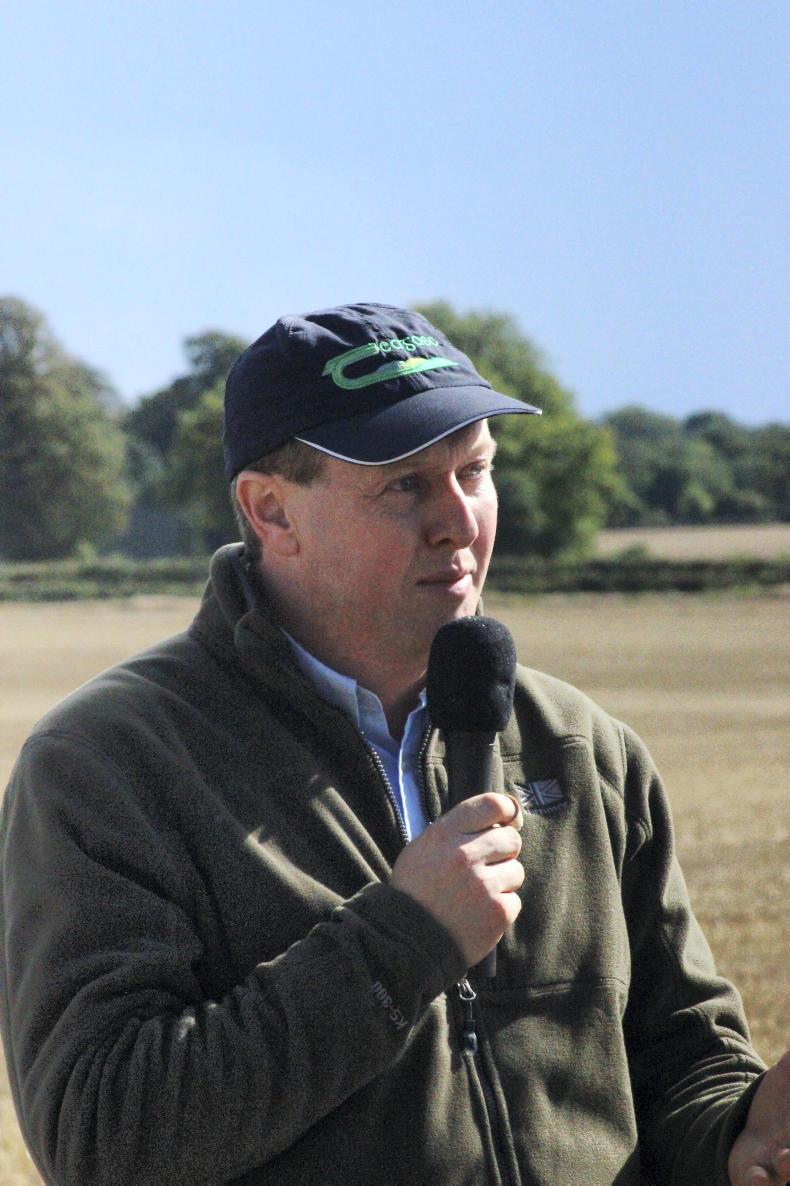Last week, Teagasc ran events on its three tillage BETTER farms. Each event focused initially on the average performance of the farm and the variability found within one or two fields on each farm.
I attended the Thursday event on the farm of Derek Jnr and Derek Keeling in north Dublin. This is a father and son business which has winter wheat as the primary crop and a level of rotation through land swopping. But while first wheats have added to yield potential, Derek Jnr said that they can still achieve good yields from continuous wheat and is reluctant to go into more rotation in the short term.
 Local Teagasc adviser Eilish Burke (pictured) said that the level of historic records available on the Keeling farm provide a significant management resource. Having regular soil test results, field fertiliser application records, crop type and yield levels are a significant resource.
Local Teagasc adviser Eilish Burke (pictured) said that the level of historic records available on the Keeling farm provide a significant management resource. Having regular soil test results, field fertiliser application records, crop type and yield levels are a significant resource.
Derek Jnr said that he does not have any precision farming tools currently, other than the historic records. That said, the availability of grant funding for precision farming equipment under TAMS (TCIS) is encouraging him to ask if some of these tools might benefit management.
The Teagasc advisers found yield variability within two of Derek’s fields. Dermot Forristal spoke about the necessity of understanding the source or cause of variation. Both Derek Jnr and Dermot asked how one should react to such variability. If you spend more in an effort to increase yield in poor patches, the cost per tonne could go up dramatically if extra yield is not produced.
Derek records show lower common costs per hectare than tillage farmers in the National Farm Survey (NFS). This lower cost, coupled with higher yield, is giving him higher common profit per tonne than the average of the NFS.
Teagasc conducted a detailed examination of fertility of one of Derek’s fields and this found that P and K levels were satisfactory to good but pH levels were on the low side and variable. Derek has responded to this by applying either two or three tonnes of lime per hectare to different parts of the field.
 Mark Plunkett (pictured) reported that yield sampling in the field identified the middle section to be higher-yielding than either end. Soil fertility was broadly similar in all areas but this centre area is normally higher yielding. Soil structure estimates were acceptable or better. Organic matter levels were also good.
Mark Plunkett (pictured) reported that yield sampling in the field identified the middle section to be higher-yielding than either end. Soil fertility was broadly similar in all areas but this centre area is normally higher yielding. Soil structure estimates were acceptable or better. Organic matter levels were also good.
Once yield variability is identified, the next thing is to try to identify the cause and to categorise it as fixable or not. Dermot Forristal explained that there are things we can correct, like pH or fertility (macro or micro) or drainage or weed patches; things we cannot change like soil texture; and things we can manage, such as soil structure or improved organic matter.
Identifying the causes of variability can itself be a challenge due to lack of year-to-year yield stability, Dermot emphasised. So the causes of variability can be difficult to find and manage. It was also emphasised that adding additional cost to specific areas via precision farming technologies would be counterproductive if these patches did not produce higher yield. It is important to remember that yield is not equal to profit, Dermot stated.
Organic matter
 Ciaran Collins (pictured) of Teagasc spoke about the benefits of applying organic manure. He valued a range or manures according to their nutrient content but acknowledged that their yield benefit could be much higher. The benefit of manures will be greatest on poorer fertility land but he also emphasised the need to match the manure with the crop.
Ciaran Collins (pictured) of Teagasc spoke about the benefits of applying organic manure. He valued a range or manures according to their nutrient content but acknowledged that their yield benefit could be much higher. The benefit of manures will be greatest on poorer fertility land but he also emphasised the need to match the manure with the crop.
He warned against using high N products like chicken litter or pig slurry ahead of winter cereals as the high N will just drive unbeneficial growth and increase susceptibility to diseases like mildew in the autumn. He recommended that farmers always test their manure sources due to their inherent variability.
Measure for success
Shay Phelan emphasised the importance of measurements on farms. Knowing things like thousand grain weight, percentage establishment, tiller production, tiller loss, ear counts, etc, can be very useful in explaining why yield variability occurs and used to alter future management.






 This is a subscriber-only article
This is a subscriber-only article










SHARING OPTIONS: